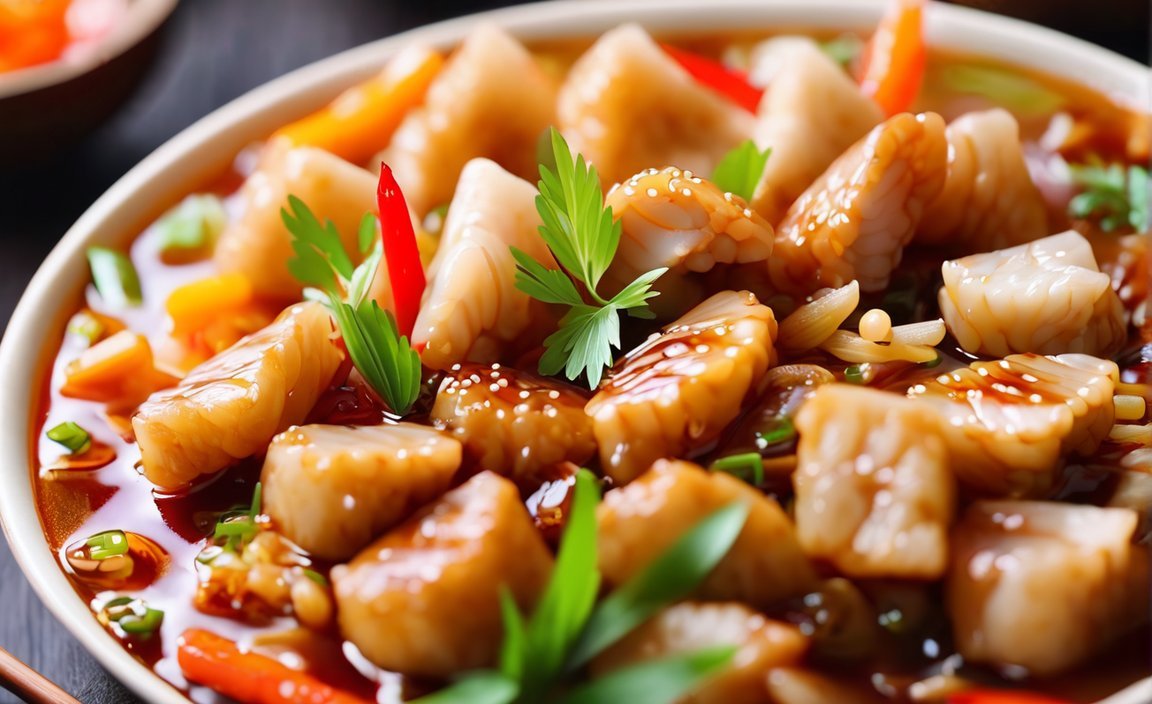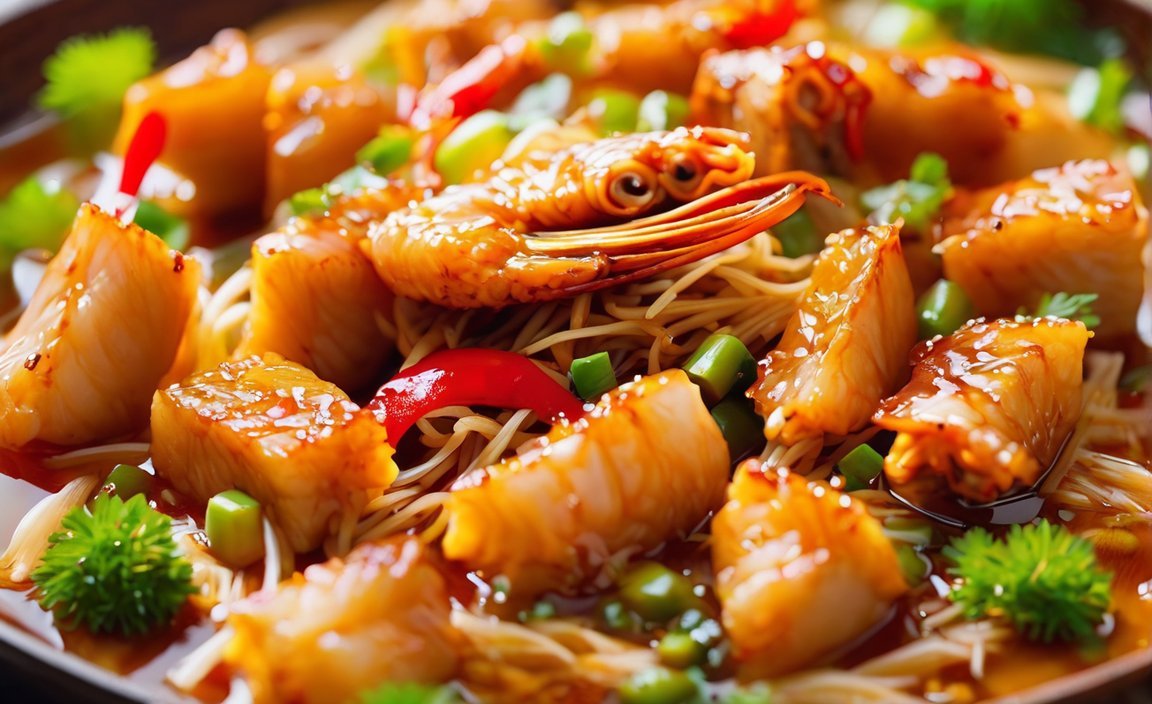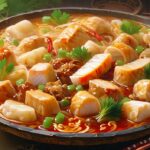Welcome to “Discovering the Delights: 10 Fascinating Facts About Chinese Food,” where we embark on a culinary journey through the vibrant world of Chinese cuisine. With its rich history, diverse flavors, and intricate cooking techniques, Chinese food has captivated taste buds around the globe. In this article, we will delve into the fascinating aspects of one of the world’s most beloved cuisines, exploring intriguing facts that will leave you hungry for more. From the cultural significance of certain dishes to the hidden secrets behind iconic ingredients, prepare to be amazed by the depth and complexity of Chinese culinary traditions. So, grab your chopsticks and join us as we uncover the ten most interesting facts about Chinese food.
Key Takeaways:
- There are eight culinary cuisines in China.
- Soup, noodles, and rice are the main foods in Chinese cuisine.
- Chinese people primarily use chopsticks as their utensils.
- Each food in Chinese culture is associated with a superstitious symbol.
- Chinese people have a wide variety of food choices and are known to eat almost everything.
- Tea originated in China and holds great cultural significance.
- China uses approximately 45 billion pairs of chopsticks each year.
10 Interesting Facts About Chinese Food

Chinese cuisine is renowned worldwide for its bold flavors and diverse culinary traditions. From the aromatic soups to the delicate dumplings, Chinese food has captivated the palates of people from all corners of the globe. In this article, we will delve into the depths of Chinese gastronomy and uncover ten fascinating facts that will leave you hungry for more.
1. Eight Culinary Cuisines of China
China is a land of culinary diversity, with each region boasting its own distinct cuisine. Known as the “eight culinary cuisines,” these regional styles include Cantonese, Sichuan, Shandong, Jiangsu, Zhejiang, Fujian, Hunan, and Anhui. Each cuisine showcases a unique blend of flavors, cooking techniques, and ingredients, offering a tantalizing journey through the different tastes of China.
2. Soup, Noodles, and Rice – China’s Culinary Staples
When it comes to Chinese cuisine, there are three staples that reign supreme – soups, noodles, and rice. These essentials form the foundation of many Chinese dishes and provide a comforting and filling meal. From the aromatic hot and sour soup to the popular street food dish, Beijing noodles, or the fragrant jasmine rice, these iconic elements shape the gastronomic landscape of Chinese food.
3. Chopsticks – The Symbol of Chinese Dining
Step into any Chinese restaurant, and you’ll find one common sight – chopsticks. Chinese people have been using these slender, elongated utensils for centuries. Chopsticks not only serve as a practical tool for eating but also hold cultural significance. They symbolize unity, as the two sticks must come together to grasp food, reflecting the communal nature of Chinese dining.
4. Food Superstitions: Symbolism on Your Plate
In Chinese culture, every food has a symbolic meaning. From longevity noodles, representing a long and prosperous life, to fish symbolizing abundance and prosperity, Chinese people believe that their choice of food can bring luck and blessings. Exploring the symbolic significance of each dish adds an extra layer of fascination to Chinese cuisine.
5. Wide Range of Food Choices – From the Bizarre to the Ordinary
Chinese cuisine offers an incredibly diverse range of food choices. Chinese people are known for their adventurous approach to food, with a saying that “Chinese people eat everything with four legs, except the table, and everything that flies, except airplanes.” While some dishes might seem peculiar to Western palates, such as century eggs or stinky tofu, others, like the delectable Peking duck or savory dim sum, have gained international popularity.
6. Tea – The Heart and Soul of Chinese Culture
Tea holds a cherished place in Chinese culture, serving as both a beverage and a symbol of hospitality. Renowned for its health benefits and soothing qualities, tea is deeply ingrained in Chinese rituals and ceremonies. From green tea to oolong tea and pu-erh tea, each variety has its unique flavor profile and medicinal properties, making tea an integral part of Chinese cuisine.
7. A Pair of Chopsticks A Day
If you’ve ever wondered how many chopsticks are used in China each year, the staggering number might surprise you. China consumes approximately 45 billion pairs of chopsticks annually, resulting in significant environmental concerns. To combat this, there has been a rising trend of using reusable chopsticks made from materials like bamboo or stainless steel.
8. Dim Sum – A Feast for the Senses
Dim sum, which translates to “touch the heart” in Cantonese, is a culinary experience like no other. Originating from the ancient teahouses along the Silk Road, dim sum is not just a meal but a social occasion. With its delectable assortment of bite-sized dishes, from steamed dumplings to crispy spring rolls, dim sum offers a feast for the senses, stimulating your taste buds while creating an atmosphere of conviviality.
9. Herbal Medicine – Cuisine for Health
Traditional Chinese Medicine (TCM) places great emphasis on the relationship between food and health. Many Chinese dishes celebrate the medicinal properties of certain ingredients, incorporating herbs and spices to nourish and heal the body. From ginseng chicken soup to herbal teas and stir-fried dishes infused with healing herbs, Chinese cuisine seamlessly blends flavor and wellness.
10. Chinese Food – A Culinary Tapestry
Chinese food is like a beautiful tapestry woven with ancient traditions, regional flavors, and a rich history. Each dish tells a story, reflecting the cultural heritage and culinary expertise of the people who prepared it. By exploring the ten fascinating facts about Chinese food, we have merely scratched the surface of this vast gastronomic world. So, grab your chopsticks and embark on a culinary journey through the vibrant and captivating realm of Chinese cuisine.
By delving into the culinary traditions, cultural symbolism, and diverse range of dishes, we have uncovered ten fascinating facts about Chinese food. This pillar blog section is designed to provide readers with an engaging and informative insight into the captivating world of Chinese cuisine, highlighting its rich history and unique flavors. So, join us on this gastronomic adventure as we discover the delightful and surprising facets of Chinese food.
If you’re curious about the 10 importance of desserts, then you definitely need to check out this article! Explore the variety of reasons why desserts are not only delicious but also beneficial for your overall well-being. Click here to uncover the secrets of the perfect sweet treat.
Emphasis on Fresh Ingredients

Chinese cuisine is renowned for its emphasis on fresh ingredients, which plays a crucial role in creating the vibrant and flavorful dishes that have captivated food enthusiasts around the world. From the bustling street markets to the high-end restaurants, Chinese cooks take pride in using the freshest produce, meats, and seafood to elevate their culinary creations. In this article, we will delve into the fascinating connection between Chinese cuisine and the importance of fresh ingredients, uncovering the secrets behind this culinary tradition.
1. Land of Abundance:
China, with its vast and diverse landscape, is blessed with an abundance of natural resources. From fertile valleys to crystal-clear rivers, the country provides a rich environment for cultivating a wide range of ingredients. With a strong agricultural tradition, Chinese farmers have perfected the art of cultivating fresh and flavorful produce, ensuring that every dish is bursting with natural flavors.
2. The Art of Seasonality:
Chinese cuisine celebrates the changing seasons and the unique flavors that each season brings. By using fresh seasonal ingredients, Chinese chefs are able to create dishes that are not only delicious but also in harmony with nature. From delicate spring greens to hearty autumn harvests, the use of seasonal produce ensures that every dish is at its peak freshness and flavor.
3. Farm-to-Table Philosophy:
The farm-to-table philosophy is deeply ingrained in Chinese culinary practices. In bustling cities like Beijing and Shanghai, local markets are a common sight, where vendors proudly display an array of fresh fruits, vegetables, and meats. Chinese cooks value the direct connection between the source of their ingredients and the dishes they create, encouraging a sense of transparency and trust in the food they serve.
4. Immerse in Nature’s Bounty:
With its vast coastline and numerous rivers, China boasts an extraordinary variety of seafood. Fresh fish, shrimp, crab, and other seafood delicacies are an integral part of Chinese cuisine. Whether it’s a delicate steamed fish or a flavorful seafood stir-fry, the use of fresh seafood elevates the taste and texture of the dish, allowing the natural flavors to shine through.
5. Local and Organic:
Chinese cuisine places a strong emphasis on local and organic ingredients. From regional specialty vegetables to heritage breeds of livestock, Chinese cooks are dedicated to preserving the unique flavors of their local ingredients. By utilizing organic produce and sustainably-raised meats, Chinese cuisine not only offers a delectable dining experience but also promotes a healthier and more sustainable way of eating.
6. From Farm to Wok:
In Chinese kitchens, the journey from farm to wok is swift and efficient. By using fresh ingredients, Chinese cooks are able to achieve vibrant colors, enticing aromas, and robust flavors in their dishes. The brief cooking time ensures that the natural flavors and nutrients are preserved, resulting in dishes that are both nutritious and delicious.
7. Fusion of Flavors:
The use of fresh ingredients in Chinese cuisine allows for a harmonious fusion of flavors. Whether it’s the balance of sweet and sour in a Cantonese dish or the bold spiciness of Szechuan cuisine, the freshness of the ingredients plays a vital role in creating the intricate flavor profiles that Chinese food is known for.
8. A Feast for the Senses:
The emphasis on fresh ingredients in Chinese cuisine not only tantalizes the taste buds but also engages all the senses. The vibrant colors of fresh vegetables, the sizzle and aroma of stir-frying, and the succulent textures of perfectly cooked seafood all contribute to an unforgettable dining experience that transcends mere sustenance.
9. Nourishment for the Body and Soul:
Chinese culture views food as nourishment for both the body and the soul. By using fresh ingredients, Chinese cuisine not only provides a source of sustenance but also promotes a sense of well-being and vitality. The use of fresh vegetables, herbs, and spices in Chinese dishes adds a nutritional boost, while the vibrant flavors satisfy the palate and bring joy to the dining experience.
10. Preserving Tradition with Freshness:
Emphasizing fresh ingredients is not only a culinary tradition but also a way of preserving Chinese cultural heritage. By using fresh produce and traditional cooking methods, Chinese cooks keep alive the centuries-old recipes and techniques that have been passed down through generations. The commitment to fresh ingredients ensures that Chinese cuisine continues to evolve while remaining true to its roots.
Key Takeaways:
- Chinese cuisine places a strong emphasis on fresh ingredients, ensuring that every dish is bursting with natural flavors.
- The farm-to-table philosophy is deeply ingrained in Chinese culinary practices, fostering a direct connection between the source of ingredients and the dishes served.
- The use of fresh seasonal ingredients celebrates the changing seasons and allows Chinese chefs to create dishes in harmony with nature.
- Chinese cuisine values local and organic ingredients, promoting a healthier and more sustainable way of eating.
- Fresh ingredients in Chinese cuisine result in vibrant colors, enticing aromas, and robust flavors that engage all the senses.
- The emphasis on fresh ingredients not only nourishes the body but also brings joy to the dining experience and preserves Chinese cultural heritage.
Sources:
– source 1
– source 2
Significance of Symbolism in Chinese Food
Chinese cuisine is not just about flavors and ingredients; it is a treasure trove of symbolism and cultural significance. Dating back thousands of years, the symbolism of foods in China is rooted in superstitions and traditional beliefs, aimed at invoking blessings or celebrating important occasions. The significance of symbolism in Chinese food can be seen in various aspects, including food names, shapes, colors, history, and legends.
Chinese New Year: Wishes for Happiness and Blessings
Chinese New Year, also known as the Spring Festival, is the most important traditional festival in China. During this festive period, there is a special emphasis on wishes for happiness and blessings. As a result, the choice of New Year foods is deliberate, as each dish carries its unique symbolic meaning. Here are two examples:
Fish: The Chinese word for fish, “yu,” sounds similar to the word for surplus or abundance. As a result, fish symbolizes wealth and prosperity, making it an essential dish during Chinese New Year celebrations.
Dumplings: Shaped like ancient Chinese silver ingots, dumplings are believed to bring wealth and good fortune. Their round shape also represents completeness and unity within the family.
(Source: China Highlights)
Lantern Festival: Reunion and Togetherness
The Lantern Festival, celebrated on the first full moon night of the Chinese calendar year, holds significant cultural importance. Along with the symbolism of the full moon, the food served during this festival signifies family reunion and togetherness. One classic dish associated with the Lantern Festival is “tangyuan,” sweet round sticky rice balls in soup. These delightful treats symbolize the unity and harmony of the family.
(Source: China Highlights)
Sister’s Meal Festival: Love and Courtship
Celebrated by the Miao ethnic people on the 15th day of the third Chinese lunar month in Guizhou Province, the Sister’s Meal Festival is a celebration of love and courtship. Colorful rice dishes, symbolizing different emotions, are prepared during this festival. It is an occasion for young Miao people to find their life partners and express their deep affections.
(Source: China Highlights)
Dragon Boat Festival: Protection Against Evil Spirits
The Dragon Boat Festival is a significant celebration in China, honoring the famous patriotic poet Qu Yuan from ancient times. One of the traditional foods associated with this festival is “zongzi,” glutinous rice dumplings wrapped in bamboo leaves. Zongzi symbolizes protection against evil spirits. The act of eating zongzi during this festival is also seen as a way to pay tribute to Qu Yuan’s patriotic spirit.
(Source: China Highlights)
Understanding the symbolism behind Chinese foods adds depth to the appreciation of Chinese culinary traditions. It showcases the rich cultural heritage and traditional beliefs embedded within each dish. From celebrating abundance and prosperity to promoting unity and love, Chinese cuisine beautifully weaves symbolism into its gastronomic offerings.
Key Takeaways:
- Chinese cuisine is filled with symbolism and cultural significance, dating back at least 2,000 years.
- Symbolism in Chinese food comes from superstitions and traditional beliefs, invoking or celebrating blessings.
- Various elements contribute to the meanings associated with Chinese foods, including food name pronunciation, shape, color, history, and legends.
- Chinese festivals such as Chinese New Year, the Lantern Festival, Sister’s Meal Festival, and Dragon Boat Festival showcase the significance of symbolism in traditional foods.
- Fish symbolizes wealth and prosperity, while dumplings represent good fortune and the unity of the family during Chinese New Year celebrations.
- Tangyuan, the sweet round sticky rice balls in soup, symbolize togetherness and harmony during the Lantern Festival.
- Colorful rice dishes prepared during the Sister’s Meal Festival symbolize love and courtship for the Miao ethnic people.
- Zongzi, glutinous rice dumplings wrapped in bamboo leaves, represent protection against evil spirits during the Dragon Boat Festival.
(Source: China Highlights)
Influence of Chinese Cuisine on Global Gastronomy
Chinese cuisine has had a profound influence on the global food industry, captivating taste buds around the world. Let’s delve into the fascinating facts that highlight the remarkable impact of Chinese food on global gastronomy.
1. Fusion Cuisine: A Harmonious Blend
Chinese cuisine’s influence on global gastronomy can be seen in the rise of fusion cuisine. Chinese immigrants and diaspora communities have introduced Chinese flavors and cooking techniques to various regions, blending them with local customs and ingredients. This fusion has given birth to delicious culinary creations that combine the best of both worlds.
2. Ubiquitous Chinese Restaurants
Chinese restaurants have become ubiquitous in cities worldwide. From bustling Chinatowns to upscale establishments, these culinary gems offer a taste of China’s rich flavors and traditions. People from all walks of life flock to Chinese restaurants, delighting in dishes that showcase the diversity and complexity of Chinese cuisine.
3. Stir-Fry: A Global Cooking Technique
Stir-frying is one of the most popular cooking techniques in Chinese cuisine, and its influence has spread far beyond China. The quick and vibrant method of cooking, often done on high heat, ensures that vegetables retain their crispness and vibrant colors, while meats are tender and succulent. This technique has been widely adopted in global kitchens, bringing the flavors of Chinese stir-fry to countless dishes.
4. Noodles: International Favorites
Chinese noodles, with their rich variety and tantalizing flavors, have become beloved around the world. Whether it’s a comforting bowl of steaming hot noodle soup or a flavorful stir-fried noodle dish, Chinese noodles have found a place in global gastronomy. From ramen in Japan to pad Thai in Thailand, the influence of Chinese noodle culture is undeniable.
5. Dim Sum: Bite-Sized Delights
Dim sum, a beloved Chinese tradition, has made its mark on global culinary scenes. Dim sum restaurants have become popular destinations for those seeking an immersive dining experience and a taste of authentic Chinese cuisine. The bite-sized delights, meticulously crafted and bursting with flavor, have captured the hearts and palates of people worldwide.
6. Chinese Ingredients: A World of Flavors
Chinese ingredients, with their unique flavors and textures, have found their way into kitchens across the globe. From staple ingredients like soy sauce, ginger, and garlic to more exotic finds like Sichuan peppercorns and lotus root, Chinese elements add depth and complexity to dishes from different cuisines.
7. Tea: A Timeless Elixir
Chinese tea culture holds a special place in global gastronomy. With its rich history and diverse range of flavors, Chinese tea has become a beverage of choice for tea enthusiasts worldwide. From delicate green tea to robust oolong, the art of brewing and savoring Chinese tea has transcended boundaries, elevating the tea-drinking experience for many.
8. Umami: The Fifth Taste
Chinese cuisine’s emphasis on balancing flavors, particularly the incorporation of umami, has influenced global gastronomy. Umami, often described as the fifth taste, adds depth and richness to dishes. Chinese ingredients like dried mushrooms, fermented soybeans, and oyster sauce are celebrated for their umami qualities, enriching dishes in various cuisines.
9. Sustainability: A Chinese Philosophy
Chinese culinary traditions have long embraced sustainability, taking advantage of abundant vegetables and utilizing every part of an ingredient. This philosophy has resonated with global chefs and food enthusiasts, sparking a greater appreciation for sustainable practices and reducing food waste.
10. Cultural Exchange Through Food
Chinese cuisine serves as a gateway to Chinese culture for people around the world. Through the exploration of Chinese food, individuals gain insights into traditions, customs, and the diverse regional flavors of China. This cultural exchange fosters a deeper understanding and appreciation of Chinese gastronomy and its global influence.
Key Takeaways:
– Chinese cuisine’s influence on global gastronomy can be seen through fusion cuisine and the blending of Chinese flavors with local customs and ingredients.
– Chinese restaurants are prevalent worldwide, offering a taste of China’s rich culinary traditions.
– The cooking technique of stir-frying, widely adopted globally, ensures vibrant and flavorful dishes.
– Chinese noodles and dim sum have become international favorites, reflecting the broad appeal of Chinese cuisine.
– Chinese ingredients, from staple sauces to exotic finds, enhance the flavors of dishes from various cuisines.
– Chinese tea culture has captivated tea enthusiasts worldwide with its diverse range of flavors and brewing techniques.
– Chinese cuisine’s emphasis on umami has influenced global gastronomy, enriching dishes with depth and richness.
– Chinese culinary traditions promote sustainability and a reduced food waste approach.
– Chinese food serves as a gateway to Chinese culture, fostering cultural exchange and understanding.
Sources:
– China Highlights – “15 Interesting Facts on Chinese Food You Probably Won’t Know”
– Atlas Obscura – “How Chinese Food Won Over the World – Gastro Obscura”
FAQ
Q1: Are there specific flavors that are important in Chinese cuisine?
A1: Yes, Traditional Chinese Medicine emphasizes the balance of five key flavors in Chinese food: sweet, sour, salty, bitter, and spicy. These flavors vary across different regions of China.
Q2: What are some popular dishes in northern and southern Chinese cuisine?
A2: In the colder north, wheat production is favored, resulting in dishes like dumplings, wheat noodles, and steamed buns. In the humid south, rice or rice noodles are commonly eaten.
Q3: Is it true that Chinese people eat unconventional foods?
A3: Yes, Chinese cuisine includes a wide variety of ingredients, and it is known for including unconventional meats like dog, insects, scorpions, and various animal parts like pig’s ears, heads, feet, and hearts.
Q4: Why is Chinese food considered healthy?
A4: Chinese food is often regarded as healthy because it emphasizes fresh ingredients, vegetables, grass-fed meats, seafood, and herbs and spices. Additionally, traditional Chinese food is almost completely dairy-free.
Q5: How has Chinese cuisine influenced the global food industry?
A5: Chinese cuisine has had a significant impact on the international food scene. Chinese immigration and the establishment of diaspora communities have led to Chinese cuisine blending with local customs and ingredients in different parts of the world. The popularity of Chinese food globally can be attributed to its rich flavors, wide range of ingredients, and the increasing willingness of diners to explore unfamiliar cuisines.









